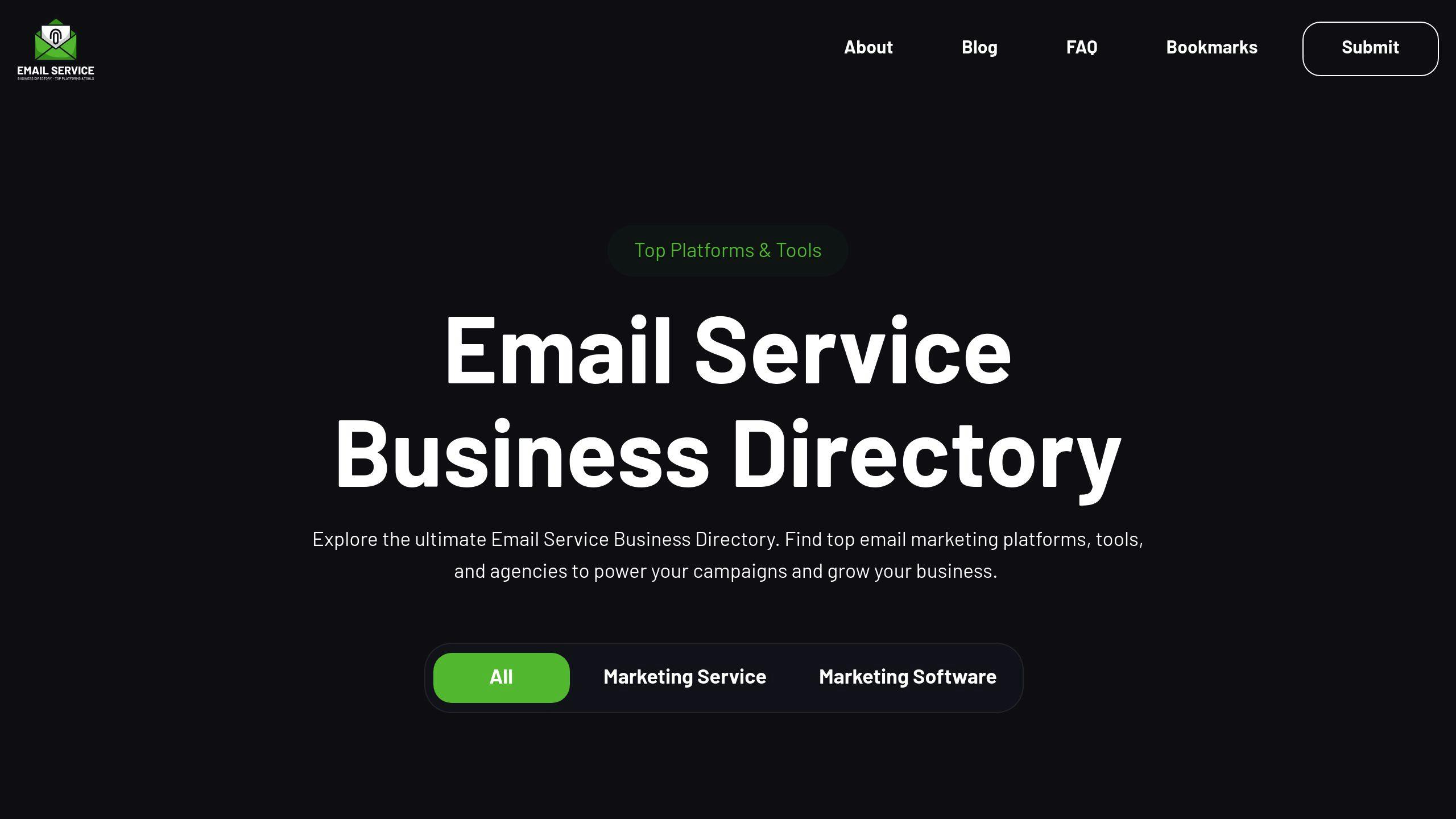Finding the right email platform is essential for effective communication and marketing. Here's what you need to focus on:
- Integration: Ensure it works with your CRM, e-commerce tools, and analytics systems.
- Deliverability: Look for features like SPF, DKIM, and compliance with GDPR and CAN-SPAM.
- Usability: Prioritize easy navigation, email creation, and strong customer support.
- Scalability: Choose a platform that can grow with your business, offering advanced tools and flexible pricing.
Quick Comparison Table
| Criteria | Key Features to Look For |
|---|---|
| Integration | CRM sync, API access, e-commerce tools |
| Deliverability | Authentication, spam testing, list cleaning |
| Usability | User-friendly editor, templates, dashboards |
| Scalability | Growth-friendly plans, predictive analytics |
Start with free trials, test features, and use resources like the Email Service Business Directory to compare platforms. Focus on your business needs today and plan for future growth.
Best Email Marketing Platforms Comparison 2024
Identifying Your Business Requirements
Before choosing an email platform, it's crucial to understand what your business actually needs. Skipping this step can lead to expensive mistakes and frustration down the road.
Setting Clear Marketing Goals
Your marketing goals should shape your platform needs. For example, if your focus is on nurturing leads, look for strong automation and segmentation tools. Running an e-commerce business? Features like cart recovery are a must.
Think about metrics like open rates, conversions, list growth, and the level of automation you require. These will help you align your goals with the right platform features.
Planning for Business Growth
One common mistake is focusing only on what you need right now, without considering future growth.
Here's a quick breakdown of platform features based on business size:
| Business Size | Must-Have Features | Growth-Friendly Options |
|---|---|---|
| Solo Professional | Basic automation, Calendar sync | Affordable pricing, Easy-to-use templates |
| Small Business | CRM integration, E-commerce tools | Scalable plans, Multi-step workflows |
| Mid-size Enterprise | Advanced segmentation, API access | Collaboration tools, Flexible integrations |
Think ahead by choosing a platform that can scale with your business. Features like dynamic segmentation, predictive analytics, and flexible pricing tiers can help as your campaigns grow more complex.
Key Criteria for Evaluating Email Platforms
When choosing an email platform, focus on three main areas: integration, deliverability, and usability. These elements are crucial to ensuring the platform meets your business needs.
Checking Integration Options
Your email platform should work effortlessly with your existing tools, especially CRM and e-commerce systems. Look for platforms with built-in integrations for popular tools and flexible API access for custom setups.
Here are some key integrations to consider:
| Integration Type | Purpose |
|---|---|
| CRM Systems | Sync customer data with real-time updates |
| E-commerce | Manage sales tracking and order data |
| Analytics Tools | Monitor performance and conversions |
| Content Management | Organize digital assets and email templates |
Once integration is covered, the next step is ensuring your emails reach inboxes while staying within legal requirements.
Evaluating Deliverability and Compliance
Deliverability is a top priority in email marketing. Choose platforms with features like SPF, DKIM, DMARC, spam testing, automated bounce handling, and list cleaning to improve inbox placement.
Compliance is equally important. Look for tools that support GDPR and CAN-SPAM regulations with features like double opt-in, unsubscribe management, consent tracking, and data privacy controls.
Reviewing Usability and Support
A user-friendly interface can significantly boost your team's efficiency. Pay close attention to the email editor, campaign management tools, and reporting dashboards. These features should strike a balance between simplicity and advanced functionality.
Support is another key factor. Evaluate response times, communication channels, and the quality of available documentation. Platforms offering multiple support options and detailed guides can save you time and headaches, no matter your technical skill level.
sbb-itb-6e7333f
Steps to Test and Confirm Platform Compatibility
Testing email platforms is crucial to ensure they meet your current demands and can handle future growth. A structured evaluation process minimizes risks and sets the stage for long-term success.
Using Free Trials and Demos
Many email platforms provide free trials, usually lasting 14 to 30 days. Use this time to test essential features such as email editors, automation tools, and integration with other systems.
| Testing Area | Key Elements to Evaluate |
|---|---|
| Core Features | Email editor, template builder, automation tools |
| Integration Testing | CRM sync, data accuracy, and system compatibility |
| Campaign Management | List segmentation, A/B testing, scheduling |
| Analytics | Reporting depth, visualizations, export options |
| Support Response | Ticket resolution, live chat, knowledge base |
Involve your team during the testing phase to gather feedback and spot potential workflow issues.
Reading User Reviews and Ratings
User reviews provide valuable insights, especially from businesses similar to yours. Pay attention to:
- Experiences from users with 6+ months of platform usage
- Feedback on customer support quality
- Real-life examples of tool integration with CRMs or e-commerce platforms
- Reports on how well the platform handles growth
Look for detailed reviews that highlight both strengths and weaknesses. This balanced view will help you understand the platform's capabilities and any potential drawbacks.
"Experts recommend prioritizing integration testing, feature evaluation, and support responsiveness to ensure long-term compatibility and success."
To keep your evaluation organized, create a scorecard that ranks platforms based on your business needs. Include criteria like ease of use, deliverability rates, customer support quality, and integration performance. This method ensures you don’t miss any critical features during the decision-making process.
After testing and collecting feedback, resources like the Email Service Business Directory can guide you further by offering a curated list of platforms tailored to your needs.
Using the Email Service Business Directory as a Resource

The Email Service Business Directory is a handy tool for assessing email platform compatibility and finding the right fit for your business needs.
Navigating the Directory
The directory's filtering system helps you zero in on platforms by features like automation, segmentation, and analytics. Here's a breakdown of what you can compare:
| Comparison Category | Available Information |
|---|---|
| Technical Features | Deliverability rates, SPF/DKIM support, API access |
| Integration Options | CRM systems, e-commerce platforms, social media |
| Compliance Standards | GDPR compliance, data security measures |
| Support Services | Response times, available channels, knowledge base |
| Pricing Structure | Plan tiers, contact limits, feature availability |
Start by filtering for must-have features. From there, dive into detailed specs for your shortlisted platforms. The directory emphasizes platforms with strong integration and scalability, making it easier to find a solution that fits your goals.
Benefits of Using the Directory
The directory streamlines the process of finding the right email platform by offering several practical advantages:
Save Time: Get all the platform details you need - features, pricing, and integrations - in one place. No more jumping between websites.
Real User Insights: Verified reviews provide a real-world look at key aspects like:
- Platform reliability during peak times and scalability for growth
- How well the platform integrates with popular tools
- The quality of customer support when issues arise
"The directory helps businesses avoid common pitfalls by providing a comprehensive resource for evaluating platforms. By using the directory, businesses can avoid choosing platforms that do not meet their specific needs or that have poor deliverability and compliance features."
Once you've tested platforms and gathered feedback, the directory acts as a final checkpoint. Use it to validate your choices and compare your top picks. For enterprise needs, filters for high-volume sending, advanced automation, and multi-team collaboration are available.
To make the most of the directory, consider creating a comparison matrix. Weigh factors like deliverability, compliance, and integrations against your business's specific requirements.
Conclusion: Steps to Choose the Right Email Platform
Choosing the right email platform requires careful consideration of your business needs and goals. Here's a straightforward framework to guide your decision-making process:
| Decision Stage | Key Actions | Things to Consider |
|---|---|---|
| Initial Assessment | Define use cases and desired features | Integration needs, current email volume |
| Technical Evaluation | Test deliverability and compliance | Authentication methods, GDPR adherence |
| Practical Testing | Explore free trials and demos | User interface, workflow functionality |
| Final Validation | Check reviews and directories | Platform reliability, support quality |
Focus on platforms that excel in deliverability and compliance - features that 34% of marketers rank as their top priority. Look for solutions that can grow with your business, offering advanced tools, flexible pricing, and API integrations.
"While list quality drives deliverability, strong platform support and authentication are essential."
For larger organizations, prioritize tools that enable team collaboration and handle high-volume campaigns. Resources like the Email Service Business Directory can provide detailed comparisons of enterprise-level options.
Ultimately, choose a platform that balances technical performance with ease of use. Consider its reputation among businesses similar to yours and its ability to meet your email marketing goals.


